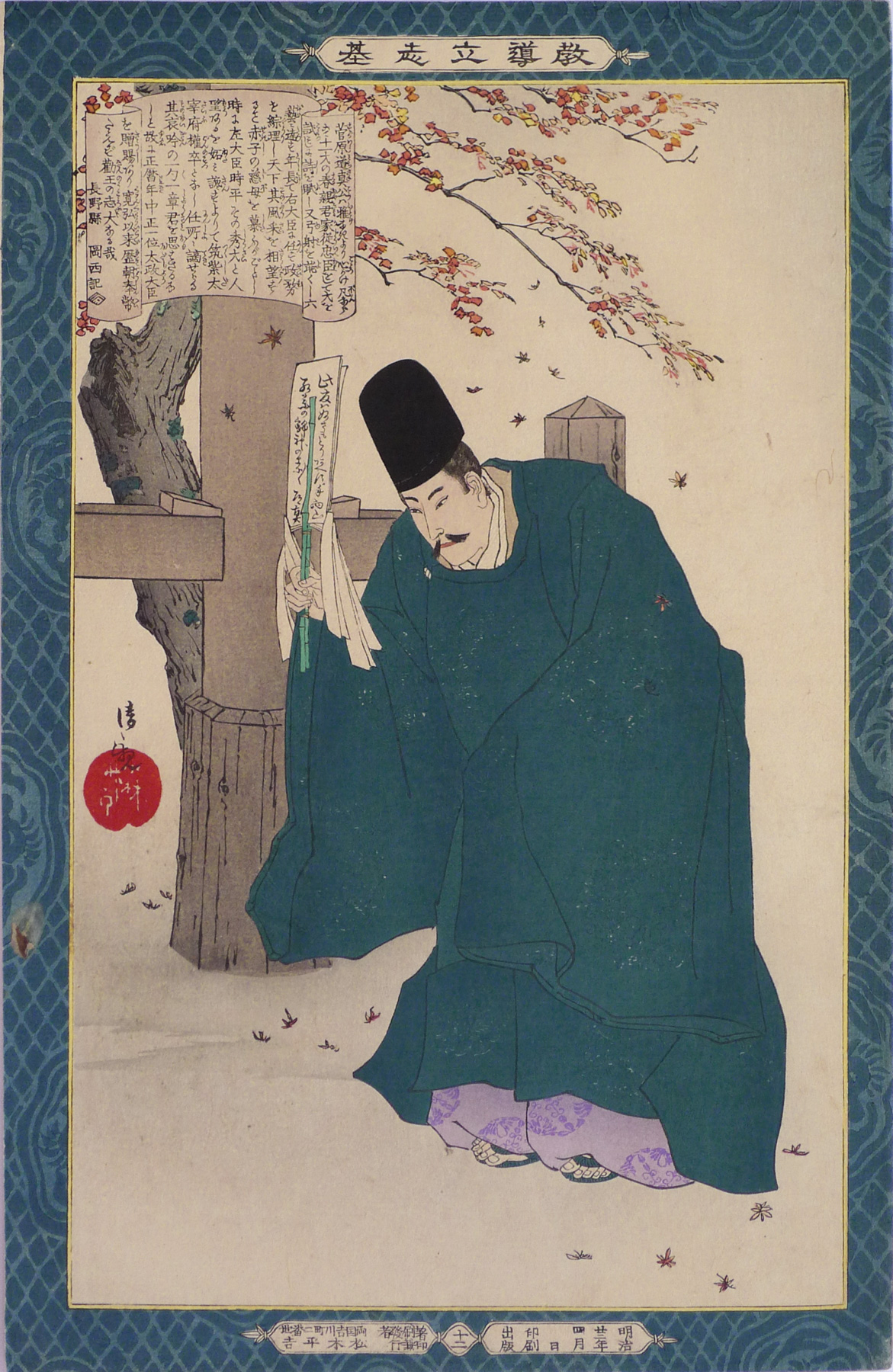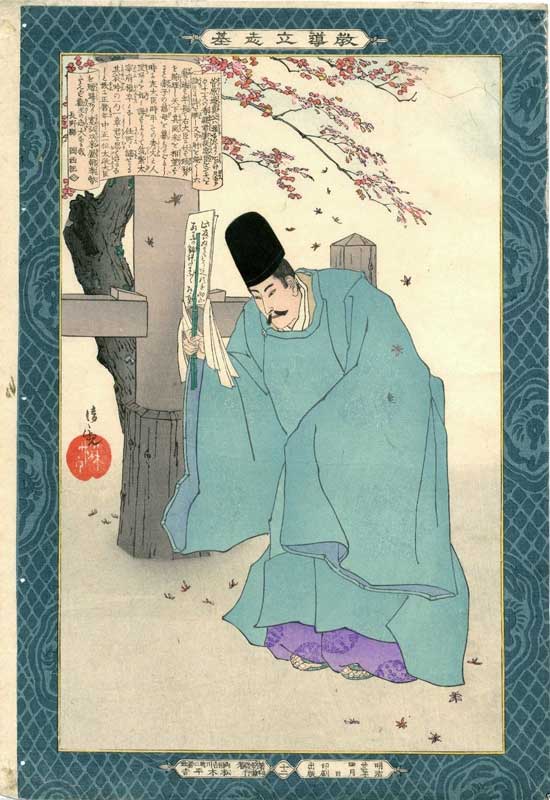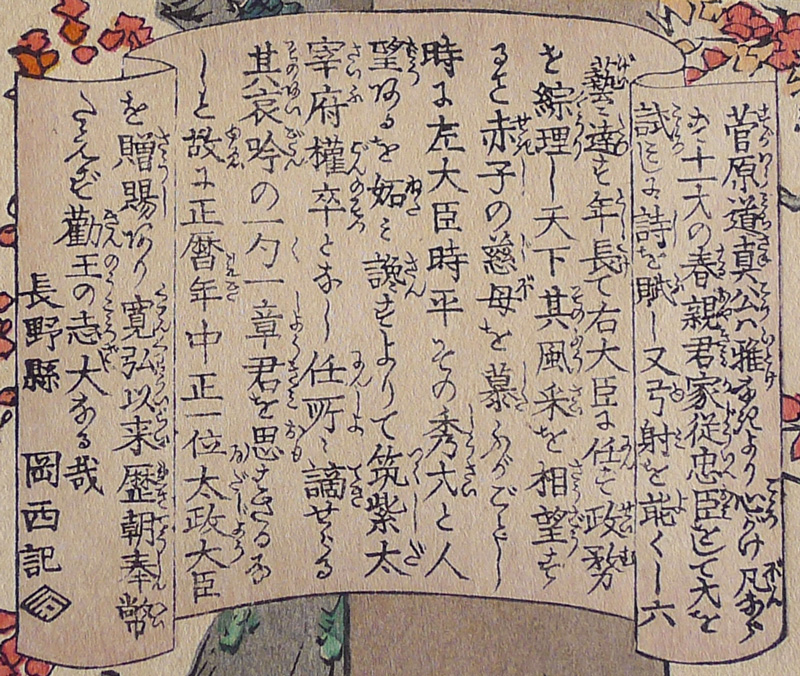About This Print
Print number 十二 (12)1 in the series Instructive Models of Lofty Ambition picturing the statesman, scholar, calligrapher and poet Sugawara no Michizane (845-903) holding a signboard containing, possibly, a petition. In the background is a plum tree, its blossoms falling, a tree much beloved by Michizane.It is unclear to me whether the print's scene is set before Michizane's exile or during his exile on Kyushu Island.
| Tokyo Metropolitan Library 401-0564 | This print is the second of two prints in this series by Kiyochika portraying Michizane in the same pose. The first print, shown left, was published in October 1885, approximately two and a half years before the April 1889 publication of the above print. The earlier work has a much more complex background which includes a rearing horse. The scroll-like cartouches on each print which provide the title of the print and information on the historical figure, contain the same text. As with several prints in this popular series, the original blocks may have been lost or damaged, requiring the publisher to request a new design from the artist and have new blocks carved. |
Kiyochika contributed twenty prints to this series. As Smith states: "Thestyle of Kiyochika’s offerings to Instructive Models of LoftyAmbition was decorous and even stiff, as befitted the didacticemphasis of the whole [series.]"2
1 Numbering of the prints was haphazard during the production of the series. Print numbers were sometimes inadvertently omitted; some prints in the series were never assigned numbers and a few of the same numbers appear on different prints.
2 Kiyochika Artist of Meiji Japan, Henry D. Smith II, Santa Barbara Museum of Art, 1988, p. 74.
Variant Printing
Sugawara no Michizane
Source: British Museum website http://www.britishmuseum.org/explore/highlights/highlight_objects/asia/s/sugawara_no_michizane_in_chine.aspxSugawara no Michizane 菅原 道真 (845-903) an outstanding cultural figure of the Heian period (794 -1185), is still widely regarded in Japan as the patron of scholarship. He was a scholar of Chinese and also a politician who rose to be Minister of the Right, one of the highest ranks in the government of the time. However, he was exiled to Kyūshū as the result of a conspiracy of the Fujiwara family. After his death in exile there were several disasters in the capital of Kyoto which people believed were caused by his angry spirit. He was therefore reinstated and raised to the rank of a Shintō deity (renamed Karai Tenjin) and the Kitano Shrine was founded in his memory. In the Muromachi period (1333-1568) there was a revival of interest in kambun (Chinese-style writing) and Michizane's reputation was re-established as the greatest Japanese poet who had written in the Chinese language.
One of his most famous poems . . . is his farewell to the beloved plum tree in his garden, written shortly before going into exile.
When blows the eastern wind,
Send to me your fragrance,
O flower of the plum
Though absent from your master,
Forget not the season of spring.
Transcription of Scroll
Source: with thanks to Yajifun http://yajifun.tumblr.com/12 Sugawara no Michizane 菅原道真公
教導立志基 十二 菅原道真公 小林清親 1889年4月
Transcription: [scroll text by 長野縣 岡西]
"菅原道真公ハ稚(いとけ)なきより心がけ凡ならず十一才の春 親君家従忠臣をして才を試ミしに詩を賦し又弓射を能くし六藝に達す 年長(としたけ)て右大臣に任ず 政務を綜理し天下其風采を相望すること赤子の慈母を慕ふがごとし 時に左大臣時平その秀才と人望あるを妬ミ讒す よりて筑紫太宰府權卒となし任所に謫せらる 其哀吟の一句一章君を思わざるなしと 故に正暦年中正一位太政大臣を贈賜あり寛弘以来歴朝奉幣たゑず 勤王の志大なる哉 長野縣 岡西 記"
About The Series "Kyōdō risshi no motoi"
Notes:1. This series is variously translated as "Instructive Models of Lofty Ambition," "Foundations of Learning and Achievement," "Foundation of Instruction and Perseverance," "Self-Made Men Worthy of Emulation," "Paragons of Instruction and Success," "Moral of Success," "Examples of Self-Made Leaders," and "Instruction in the Fundamentals of Success." The title in Japanese is sometimes seen as "Kyōdō risshiki or "Kyōdō risshi no moto," in addition to the most commonly seen transliteration of "Kyōdō risshi no motoi".
2. For a complete listing of all the prints in the series and additional information please see the article on this site titled Instructive Models of Lofty Ambition.
This series ran between October 1885 and November 1890 and featured a long list of heroes and heroines, from antiquity to contemporary times, who were regarded as standards of moral leadership and self-realization.
Source: Kiyochika Artist of Meiji Japan, Henry D. Smith II, Santa Barbara Museum of Art, 1988, p. 74-75; original research and as footnoted.
This series of 58 prints,1 plus a table of contents sheet (目録), were originally published between October 1885 and November 1890 by the Tokyo publisher Matsuki Heikichi 松木平吉.2 The table of contents sheet issued by the publisher states that "fifty prints make up the complete set (五十番揃)". Three prints not in the initial release were added over the five year publication period, as were five redesigns of original prints, eventually increasing the total print count to 58. The seven artists contributing prints were Kobayashi Kiyochika (1847-1915) [20 prints], Mizuno Toshikata (1866-1908) [16 prints], Inoue Tankei (Yasuji) (1864-1889) [13 prints], Taiso (Tsukioka) Yoshitoshi (1839-1892) [5 prints], Yōshū Chikanobu (1838-1912) [2 prints], Toyohara Kunichika (1835–1900) [1 print], and Hachisuka (Utagawa) Kuniaki II (1835-1888) [1 print]. All the artists, with the exception of Yōshū Chikanobu, are listed in the top scroll of the table of contents sheet. Various colors (including blue, blue/green, and tan/brown) were used for the decorative border, and in 1902 the series was re-issued by Matsuki without borders.
This series of 58 prints,1 plus a table of contents sheet (目録), were originally published between October 1885 and November 1890 by the Tokyo publisher Matsuki Heikichi 松木平吉.2 The table of contents sheet issued by the publisher states that "fifty prints make up the complete set (五十番揃)". Three prints not in the initial release were added over the five year publication period, as were five redesigns of original prints, eventually increasing the total print count to 58. The seven artists contributing prints were Kobayashi Kiyochika (1847-1915) [20 prints], Mizuno Toshikata (1866-1908) [16 prints], Inoue Tankei (Yasuji) (1864-1889) [13 prints], Taiso (Tsukioka) Yoshitoshi (1839-1892) [5 prints], Yōshū Chikanobu (1838-1912) [2 prints], Toyohara Kunichika (1835–1900) [1 print], and Hachisuka (Utagawa) Kuniaki II (1835-1888) [1 print]. All the artists, with the exception of Yōshū Chikanobu, are listed in the top scroll of the table of contents sheet. Various colors (including blue, blue/green, and tan/brown) were used for the decorative border, and in 1902 the series was re-issued by Matsuki without borders.
Brief texts contained within a scroll-like cartouche appearing on each print provide historical details. The scroll composer's name is given at the end of the scroll text. The “lofty ambition” of the title is a Confucian concept, originally from Mencius, meaning “righteous determination that would inspire others.” The market for the series probably included former samurai, ambitious youth, and conservative intellectuals.
"[W]hen it was completed in 1890 the publisher was singled out for special recognition by the government for having sponsored such noble subject matter."3
1 The Tokyo Metropolitan Library online collection shows 50 prints and a Table of Contents sheet. The Table of Contents lists the titles of 50 prints. Smith in Kiyochika Artist of Meiji Japan identified 52 prints. I have identified 58 prints from this series including five prints (Ikina, Michizane Sugiwara, Kesa Gozen, Soga Brothers and Hokiichi Hanawa) that were re-designed and re-printed, likely due to damaged or lost blocks.
2 Robert Schaap notes in Appendix II, p. 166 of Yoshitoshi, Masterpieces from the Ed Freis Collection, Chris Uhlenbeck and Amy Reigle Newland, Hotei Publishing, 2011 that the series originally appeared as newspaper supplements.
3 The World of the Meiji Print: Impressions of a New Civilization, Julia Meech-Pekarik, Weatherhill, 1986, p. 122.
Print Details
| IHL Catalog | #582 |
| Title or Description | Sugawara no Michizane 菅原道真公 |
| Series | “Instructive Models of Lofty Ambition” (Kyodo risshiki 教導立志基) [note: seriestitle also listed as 'Kyodo Risshi no Moto', ‘Kyodo risshi no motoi’,‘Kyōdō risshi ki’ and variously translated as “Moral of success” or“Foundations of learning and achievement” or “Self-made Men Worthy ofEmulation”' or “Examples of Self-made Leaders” or "Paragons of instruction and success"] |
| Artist | Kiyochika Kobayashi (1847-1915) |
| Signature |  |
| Seal | artist's unread red circular seal below signature |
| Publication Date | April 1889 明治廿二年 四月 |
| Publisher | Matsuki Heikichi (松木平吉) proprietor of Daikokuya Heikichi [Marks: seal not shown; pub. ref. 029] click to enlarge (from right to left) publishing and printing date: 明治廿二年 四月 日 印刷 出版 [notification delivered, Meiji 22nd year 4th month] assigned number within series: 十二 [12] publisher information: 著刷發者 両国吉川町二番地 印兼行 松木平吉 [publisher and printer Ryōgoku Yoshikawachō 2-banchi Matsuki Heikichi] |
| Engraver | |
| Impression | excellent |
| Colors | excellent |
| Condition | good - Japanese album backing paper; minor marks and flaws |
| Genre | ukiyo-e; rishki-e; kyōiku nishiki-e |
| Miscellaneous | print number 12 (十二); position 7 in the Table of Contents for the series |
| Format | vertical oban |
| H x W Paper | 14 1/8 x 9 1/4 in. (35.9 x 23.5 cm) |
| H x W Image | 12 5/8 x 8 in. (32.1 x 20.3 cm) area inside brocade border |
| Literature | |
| Collections This Print | Smithsonian National Museum of Asian Art S2003.8.1207; Museum of Fine Arts, Boston 63.782; Tokyo Metropolitan Library 280-K022 |





